Gennaro Cuofano's Blog, page 188
November 18, 2020
What Is A Business Plan And Why It Matters In Business
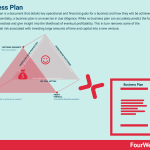
A business plan is a document that details key operational and financial goals for a business and how they will be achieved in the future. Essentially, a business plan is an exercise in due diligence. While no business plan can accurately predict the future, they do demonstrate and give insight into the likelihood of eventual profitability. This in turn removes some of the entrepreneurial risk associated with investing large amounts of time and capital into a new venture.
A typical business plan structure
Business plan structure varies considerably across industries, but most incorporate these parts as a part of a 10 to 20-page document.
Business concept – what is the nature of the industry the business intends to operate in? What is the structure of the business and what are the products or services it will offer? How will it achieve success?Marketplace analysis – who is the potential target audience and why are they motivated to buy? Is there an existing demand for the product or service? In this part, it’s crucial to be as detailed as possible. Develop a target demographic and associated buyer persona through in-depth research.Competitive analysis – who are the main competitors and what are their strengths and weaknesses? Is the market saturated or impenetrable? If the market does have established players, then strategies must be devised to acquire market share.Financial plan – if financing is required, then a sound financial plan will be key in attracting capital from banks, investors, or venture capitalists. As best as possible, develop income and cash flow statements, balance sheets, and break-even analyses. The goal here is to convince interested parties that the business has a realistic chance of success.Management and legal structure – how will the company be structured and who will lead it? What skills do management bring to the table and how will they contribute to success? A sound business plan should also define the intended legal structure, whether that be incorporated, partnership, sole proprietor, or LLC.
The four main categories of business plans
Business plans usually fall under one of four main categories:
The mini-plan – used to quickly test a concept or gauge the interest of a prospective investment partner. Mini-plans are typically short at 1-10 pages in length.The working plan – used to describe how a business could operate once established. The working plan is primarily an internal document; it does not need to look attractive with supporting photography, formatting, and appendices.The presentation plan – or a working plan submitted to interested external parties. Industry jargon and slang should be removed in favor of standard business language. The presentation plan should incorporate all aspects of a typical business plan structure. Attention to detail is also a must. Figures must be correct and words free of typing errors. The plan should also be professionally bound and printed.The electronic plan – in the digital age, many organizations find it useful to keep electronic copies of their business plans. These are useful for savvy investors who want to delve into complex spreadsheets for analysis. They are also ideal for presentations and virtual meetings.
Key takeaways
A business plan is a comprehensive document that highlights the goals of a business and how it plans to achieve them.A business plan is essential for new businesses where due diligence is crucial in attracting external investment or predicting long-term viability. All businesses – regardless of maturity – should use and adhere to such a plan.There are four main categories of business plans, with each category suited to a particular stage of the business life cycle.
Other Business Tools
[image error]It’s possible to identify the key players that overlap with a company’s business model with a competitor analysis. This overlapping can be analyzed in terms of key customers, technologies, distribution, and financial models. When all those elements are analyzed, it is possible to map all the facets of competition for a tech business model to understand better where a business stands in the marketplace and its possible future developments.
[image error]Porter’s Five Forces is a model that helps organizations to gain a better understanding of their industries and competition. Published for the first time by Professor Michael Porter in his book “Competitive Strategy” in the 1980s. The model breaks down industries and markets by analyzing them through five forces
[image error]Porter’s Diamond Model is a diamond-shaped framework that explains why specific industries in a nation become internationally competitive while those in other nations do not. The model was first published in Michael Porter’s 1990 book The Competitive Advantage of Nations. This framework looks at the firm strategy, structure/rivalry, factor conditions, demand conditions, related and supporting industries.
[image error]Developed by American academic Michael Porter, the Four Corners Analysis helps a business understand its particular competitive landscape. The analysis is a form of competitive intelligence where a business determines its future strategy by assessing its competitors’ strategy, looking at four elements: drivers, current strategy, management assumptions, and capabilities.
[image error]First proposed by accounting academic Robert Kaplan, the balanced scorecard is a management system that allows an organization to focus on big-picture strategic goals. The four perspectives of the balanced scorecard include financial, customer, business process, and organizational capacity. From there, according to the balanced scorecard, it’s possible to have a holistic view of the business.
[image error]Businesses use scenario planning to make assumptions on future events and how their respective business environments may change in response to those future events. Therefore, scenario planning identifies specific uncertainties – or different realities and how they might affect future business operations. Scenario planning attempts at better strategic decision making by avoiding two pitfalls: underprediction, and overprediction.
[image error]A one-page business plan is a simple tool to clear your mind. It focuses on three questions: What core problem am I solving? Who are my potential key customers? Where do I find them? It helps define the problem, profile the key customer, and find the key distribution channel.
Read More:
Business ModelsBusiness StrategyMarketing StrategyBusiness Model InnovationPlatform Business ModelsNetwork Effects In A NutshellDigital Business Models
The post What Is A Business Plan And Why It Matters In Business appeared first on FourWeekMBA.
Bundling Bias
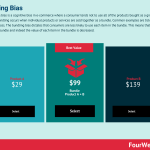
The bundling bias is a cognitive bias in e-commerce where a consumer tends not to use all of the products bought as a group, or bundle. Bundling occurs when individual products or services are sold together as a bundle. Common examples are tickets and experiences. The bundling bias dictates that consumers are less likely to use each item in the bundle. This means that the value of the bundle and indeed the value of each item in the bundle is decreased.
Understanding the bundling bias
Bundling occurs when individual products or services are sold together as a bundle. Common examples are tickets and experiences. The bundling bias dictates that consumers are less likely to use each item in the bundle. This means that the value of the bundle and indeed the value of each item in the bundle is decreased.
To explain this concept using an example, consider a cinema offering a bundle of five movie tickets for $51 – much cheaper than the $75 it would cost to buy each ticket separately. However, the bundled tickets are only valid for a month.
Let’s say that the consumer is a movie fanatic and manages to see three movies during those 30 days. With the remaining two tickets now invalid, the consumer has essentially paid $17 per ticket. If they had opted to buy three separate tickets, they would have paid $15 per ticket. Here, the bundling bias caused the consumer to spend more and in the process, receive less.
Exploiting the bundling bias in business and marketing
Businesses who sell bundled packages invariably increase sales and profit generation. If we return to the example of the movie fanatic, the cinema made an extra $2 on each movie the consumer attended. But it’s important to note that the cinema owner makes money on each ticket sold in the bundle – regardless of whether the consumer attends each of the five movies.
Of course, if the cinema also owns a candy bar, then it may lose out on sales if movies are less well attended. However, management can simply anticipate a lack of patronage by selling more tickets above and beyond cinema capacity.
Research has also shown that the nature of bundling is important for businesses. Physically bundling products together was found to be much more effective than the digital or monetary bundling of items
Bundling bias and the sunk-cost fallacy
The bundling bias has strong links to the sunk-cost fallacy, which is another cognitive bias describing consumer tendencies to follow through on something if money has been invested into it. If the movie-goer buys a single bundle of five tickets but sees three movies in a month, they are likely to determine that they have followed through on their investment.
This is because the bundle constitutes one “investment” – or purchase – and not five as in the case of buying each ticket separately. Bundling items also makes the cost of each ticket (and thus the cost of recouping the investment) less obvious to the consumer.
Key takeaways:
The bundling bias describes the human tendency to not make use of each product or service bought in a bundle.The bundling bias can be exploited by businesses with smart marketing strategies. Anticipating that consumers will not use every product or service in a bundle, they can simply sell more to increase profits.The bundling bias is closely related to another bias in the sunk-cost fallacy. With the cost of each product in the bundle less clear, recouping the initial investment becomes largely subjective which often leads to a reduction in bundle value.
Read More:
Business ModelsBusiness StrategyMarketing StrategyBusiness Model InnovationPlatform Business ModelsNetwork Effects In A NutshellDigital Business Models
The post Bundling Bias appeared first on FourWeekMBA.
Agile Project Management
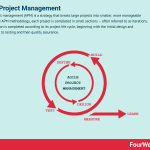
Agile project management (APM) is a strategy that breaks large projects into smaller, more manageable tasks. In the APM methodology, each project is completed in small sections – often referred to as iterations. Each iteration is completed according to its project life cycle, beginning with the initial design and progressing to testing and then quality assurance.
Understanding agile project management
In a dynamic and complex world, businesses must be able to change direction and adapt quickly.
While the software and marketing industries are perhaps most associated with APM, all businesses can benefit from adopting agile methodology. Indeed, it is now being utilized in car manufacturing, universities, and also for military purposes to name a few.
The time that it takes for an iteration to be completed is called a sprint, and sprints typically run for a few days or as many as four weeks. Ultimately, this approach to project management allows iterations to be released as they are completed.
Upon release, each iteration is then critiqued by a review team composed of key stakeholders. These stakeholders gain insights from the current iteration to guide the direction of the next iteration (step) in the process.
The four key values of the agile project management
The APM framework is based on the Agile Manifesto which was originally written to guide software development. However, the four key values listed in the manifesto can be applied to almost any industry that has a focus on meeting consumer needs.
They are:
Individuals and interactions over processes and tools. In the face of advanced technology, the APM framework still recognizes the importance of human input.Working software over comprehensive documentation. When project teams avoid being bogged down by small, insignificant details, they can focus on delivering results.Customer collaboration over contract negotiation. Traditionally, customers are only involved at the beginning and end of project management. However, in APM the customer is involved with every step of the process to ensure their input is incorporated.Responding to change over following a plan. Agile project management works with change instead of actively trying to resist it. It emphasis creating a minimum viable product (MVP) at regular intervals as the process moves from iteration to iteration.
Advantages of the agile project management approach
Early error detection. By allowing faults to be detected as they occur, agile project management negates the need for expense fixes once a product has gone to market. When travel company Thomas Cook found that their slow website left customers unable to purchase, they switched to APM. Over the next 3 months, the company was able to detect loading errors early and recouped an estimated $190,000 in lost business.Empowerment. The APM approach increases trust, builds accountability, and encourages a diverse range of ideas. As a result, projects are delivered efficiently with a focus on continuous improvement and user experience.Increased sales and profits. Businesses who adopt a more agile approach spend less time and thus less money developing products. But perhaps the single biggest cost-saving lies in the decreased reliance on expert consultation to guide the development process. In the APM approach, the experience level of junior engineers and developers is fast-tracked through hands-on learning.
Key takeaways:
Agile project management is an iterative development framework that breaks large projects into smaller parts, known as iterations.Agile project management advocates human over machine input and a focus on delivering results. It also focuses on customer collaboration and continuous product improvement.Agile project management allows businesses to develop products efficiently without an over-reliance on expensive consultation fees.
Read Next: MVP, Lean Canvas, Scrum, Design Thinking, VTDF Framework.
Read More:
Business ModelsBusiness StrategyMarketing StrategyBusiness Model InnovationPlatform Business ModelsNetwork Effects In A NutshellDigital Business Models
The post Agile Project Management appeared first on FourWeekMBA.
Action Priority Matrix
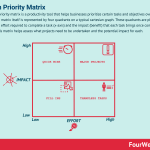
An action priority matrix is a productivity tool that helps businesses prioritize certain tasks and objectives over others. The matrix itself is represented by four quadrants on a typical cartesian graph. These quadrants are plotted against the effort required to complete a task (x-axis) and the impact (benefit) that each task brings once completed (y-axis). This matrix helps assess what projects need to be undertaken and the potential impact for each.
Understanding the action priority matrix
The action priority matrix (APM) is a diagrammatic representation that clearly illustrates which activities must be finished on time and which can be left until a later date. The APM has important implications for businesses. Those who make wise choices on which tasks to pursue first maximize return on investment. Conversely, those who make poor choices devote themselves to time and resource-intensive tasks that hinder growth.
This yields four categories:
Quick wins (high impact, low effort) – the most desirable tasks because of their ability to deliver a worthwhile return for relatively little effort.Major projects (high impact, high effort) – major projects yield great returns but they are often time and resource-intensive. As a result, they have the potential to negate several smaller and quicker wins.Fill-ins – (low impact, low effort) – including tasks such as filing, data entry, and email. While they are low in effort and in most cases essential, their impact is minimal.Thankless tasks (high effort, low impact) – otherwise known as hard slog tasks, they should be avoided wherever possible.
Creating an action priority matrix
In the action priority matrix model, effort can denote such things as cost, time, organizational obstacles, or any obstacle that might impede a task being performed. Impact can be measured quantitatively (profitability, revenue, cost) or qualitatively (morale, brand image, customer perception).
To categorize specific tasks, assign scores based on the effort and subsequent benefits of each task. While the exact scoring system is less important, many choose to use the school grading model (A to F) or a simply 1-10 scale. When scoring, businesses must use common sense when values fall close to quadrant boundaries. For example, a task with a score of 4.9 is categorized as a thankless task while one with a very similar score of 5.1 is a major project.
Once each task has been scored, plot them on the matrix according to their assigned values. As a general rule, quick wins should be prioritized and the remaining time spent on major projects. This is a useful strategy for businesses seeking to boost morale or build momentum quickly. Low impact, low effort fill-in activities should be delegated, outsourced, or avoided completely.
Key takeaways:
An action priority matrix allows businesses to prioritize efficient and intelligent decisions.An action priority matrix is separated into four quadrants, according to the degree of effort and the potential benefits of a specific task.Action priority matrices can utilize a wide range of parameters specific to business operations. However, care must be taken when scoring to ensure that businesses do not focus their efforts in the wrong areas.
Read More:
Business ModelsBusiness StrategyMarketing StrategyBusiness Model InnovationPlatform Business ModelsNetwork Effects In A NutshellDigital Business Models
The post Action Priority Matrix appeared first on FourWeekMBA.
7 Cs Of Communication
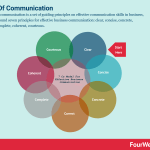
The 7Cs of communication is a set of guiding principles on effective communication skills in business, moving around seven principles for effective business communication: clear, concise, concrete, correct, complete, coherent, courteous.
Understanding the 7 Cs of communication
Effective communication in business occurs when one party receives a message in a way that it was intended to be heard. But with corporate employees spending up to 30% of work time responding to email alone, communication must be also productive, efficient, and engaging.
To that end, the 7Cs of communication were developed to improve both written and oral communication.
Following is a look at each principle.
Clear. Communication must be clear in the sense that the recipient does not have to seek further clarification on what was said. Here, it’s best to keep things simple. Avoid complex words and do not assume that the recipient has every detail of the story in front of them.Concise. Brevity is important because it saves time. Avoid using five sentences to communicate something that could be explained in two. Ultimately, conciseness is a balancing act. Employees must get their point across quickly without omitting important details.Concrete. Concrete communication is specific and logical. Facts must support each other and the premise of the communication itself. Where appropriate, facts in the form of data should also support arguments.Correct. Ensure that all communication is free of typing and spelling errors. Avoid over-reliance on spell checking tools because they do not catch subtle variations in grammar or word usage. If using technical terms, ensure that the recipient has an adequate grasp of the subject matter.Complete. Does communication have the required information for the recipient to take action? Indeed, is there a call to action included in the closing remarks?Coherent. Sentences should flow harmoniously and most importantly, be on topic. Avoid mentioning distracting topics that could easily be addressed in subsequent communication.Courteous. Manners and politeness go a long way, particularly in high-stress environments common to many businesses. Avoid coming across as demanding or brusque. Instead, opt to communicate with a friendly, professional, respectful, and considerate tone.
Extensions to the 7 Cs of communication
While the original framework is more than sufficient for effective communication, some extensions do exist.
The first is credibility. In other words, does the communication enhance or showcase the credibility of the communicator? This is particularly important for businesses giving presentations or in other scenarios where a business is less acquainted with an interested party.
The second extension is creativity. Creative communication increases engagement and again, can enhance the credibility of a business presenting to an audience.
Key takeaways:
The 7 Cs of communication provide a framework for effective and efficient business communication.The 7 Cs of communication detail 7 guiding principles. Is the communication clear, concise, concrete, complete, correct, coherent, and courteous?The 7 Cs of communication provide many benefits for individuals and businesses alike. Proper communication boosts credibility and engagement which builds solid relationships.
Read More:
Business ModelsBusiness StrategyMarketing StrategyBusiness Model InnovationPlatform Business ModelsNetwork Effects In A NutshellDigital Business Models
The post 7 Cs Of Communication appeared first on FourWeekMBA.
360-Degree Feedback
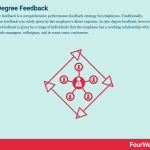
360-degree feedback is a comprehensive performance feedback strategy for employees. Traditionally, performance feedback was solely given by the employee’s direct superior. In 360 degree feedback, however, anonymous feedback is given by a range of individuals that the employee has a working relationship with. These include managers, colleagues, and in some cases, customers.
Understanding 360-degree feedback
In the evaluation itself, the employee is judged against certain behavioral, competency, and result-based criteria. Since this form of feedback involves consulting many people, a well-rounded opinion of the employee in question is formed. In turn, this guides future decisions in human resource management – such as who should be promoted, transferred, terminated, or earn a performance bonus.
Implementing 360-degree feedback
A performance questionnaire should first be distributed to the relevant participants by following these steps:
Select 6-10 participants who can give an accurate and detailed evaluation of the employee. Remember to keep the evaluation anonymous.Group participants according to the nature of their relationship with the employee. For example, clients, colleagues, and customers.Survey questions should be open-ended and address core competencies such as leadership and communication. The employee receiving evaluation should also answer the same set of questions. For best results, consider hiring an external agency to manage the evaluation process.
After the evaluation has been completed, it’s important that:
Feedback is presented in a report highlighting areas for improvement.The information is used to provide direction for employee development plans.Survey participants must be adept at providing objective and constructive criticism.Support is offered to the employee to assist in professional development.
Strengths and weaknesses of 360-degree feedback
There are many strengths to this comprehensive strategy. Some of the more pertinent are listed below.
Increases employee self-awareness. Instead of simply being judged according to predetermined performance metrics, employees gain valuable insight into their personality, motivations, and strengths and weaknesses.Encourages continuous improvement. 360-degree feedback emphasizes an incremental and collaborative approach to performance improvement. With less of a focus on hitting large milestones, the employee feels confident and empowered to meet personal goals gradually.Suitable for large organizations with decentralized workforces. In larger businesses, many employees are autonomous and do not have much interaction with direct supervisors. This form of feedback ensures that employees get access to fair and constructive feedback.
However, there are some weaknesses to 360-degree feedback:
Conflicting feedback. With such a wide and varied range of participants consulted, it is perhaps inevitable that survey answers will contradict each other.Non-specific questions. If survey questions are poorly designed, then the questions do not give any valuable insights that can be assessed quantitatively. In some cases, employees may also not be adequately trained in giving performance evaluation.Vulnerable to manipulation. Some employees may deliberately target colleagues they’ve not enjoyed a sound working relationship with. Others may provide answers with the sole intent of winning the employee in question a promotion or raise.
Key takeaways:
360-degree feedback allows an employee to receive a comprehensive performance evaluation from managers, peers, colleagues, and customers.360-degree feedback relies on quantitative data in survey answers to guide future direction on human resource management.360-degree feedback is process-centric and gives employees valuable personal insights. However, it is not immune to exploitation and manipulation by interested parties.
Read More:
Business ModelsBusiness StrategyMarketing StrategyBusiness Model InnovationPlatform Business ModelsNetwork Effects In A NutshellDigital Business Models
The post 360-Degree Feedback appeared first on FourWeekMBA.
November 17, 2020
IaaS vs. PaaS vs. SaaS
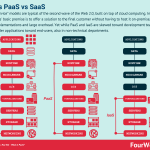
The “as-a-service” models are typical of the second wave of the Web 2.0, built on top of cloud computing. Indeed, these models‘ basic premise is to offer a solution to the final customer without having to host it on-premise, with complex implementations and large overhead. Yet while PaaS and IaaS are skewed toward development teams. SaaS has wider applications toward end-users, also in non-technical departments.
Infrastructure as a service (IaaS)
[image error]IaaS stands for infrastructure as a service. Together with other “as-a-service” models, the basic premise of this model is to offer a solution to the final customer without having to host it on-premise, with complex implementations and large overhead. The IaaS model provides virtualization, storage, network, and servers where the final user/customer will handle applications, data, operating systems, and run times.
Read Also: IaaS Business Model
Platform as a service (PaaS)
[image error]PaaS stands for the platform as a service. Together with other “as-a-service” models, this model’s basic premise is to offer a solution to the final customer without having to host it on-premise, with complex implementations and large overhead. The PaaS model is a form of evolved cloud computing. The provider, together with virtualization, storage, network, and servers, provides middleware and runtime to the user/customer, which only handles data and applications.
Read Also: PaaS Business Model
Software as a service (SaaS)
[image error]In the SaaS model, the provider also makes the applications available to the final user on top of the cloud. The applications and data are hosted and maintained with the third-party SaaS provider, enabling the user/customer to have a quick and easy setup and no overhead.
Read Also: What Is SaaS
Read More:
Business ModelsBusiness StrategyMarketing StrategyBusiness Model InnovationPlatform Business ModelsNetwork Effects In A NutshellDigital Business Models
The post IaaS vs. PaaS vs. SaaS appeared first on FourWeekMBA.
PaaS Business Model
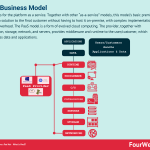
PaaS stands for the platform as a service. Together with other “as-a-service” models, this model‘s basic premise is to offer a solution to the final customer without having to host it on-premise, with complex implementations and large overhead. The PaaS model is a form of evolved cloud computing. The provider, together with virtualization, storage, network, and servers, provides middleware and runtime to the user/customer, which only handles data and applications.
 Image Source: Microsoft Azure, What Is PaaS?
Image Source: Microsoft Azure, What Is PaaS?The different layers of companies built on top of the various “as-a-service” models. From IaaS which is in the middle bottom, to SaaS which also handles the applications for the final user. PaaS is in the middle, as the PaaS provider also manages middleware and runtime, while the user manages data and applications built on top of the PaaS.
PaaS applications and examples
In the PaaS model, the platform that enables the applications’ development is handled by the PaaS provider, where the final user/customer (usually development teams) will handle the application and data itself. Therefore, the PaaS provides a platform where users can develop and deploy their own applications, with the advantage of an agile infrastructure, not hosted on-premise, and therefore faster to implement and more flexible.
Some PaaS providers also include Microsoft Azure, Google Cloud, Amazon AWS, IBM Cloud, where together with the cloud infrastructure (IaaS), the platform to develop and deploy applications on top of the cloud is offered.
This makes it possible for the user/customer of the PaaS provider to only focus on developing and deploying applications, rather than developing the whole infrastructure.
Read More:
Business ModelsBusiness StrategyMarketing StrategyBusiness Model InnovationPlatform Business ModelsNetwork Effects In A NutshellDigital Business Models
The post PaaS Business Model appeared first on FourWeekMBA.
IaaS Business Model
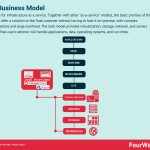
IaaS stands for infrastructure as a service. Together with other “as-a-service” models, the basic premise of this model is to offer a solution to the final customer without having to host it on-premise, with complex implementations and large overhead. The IaaS model provides virtualization, storage, network, and servers where the final user/customer will handle applications, data, operating systems, and run times.
Breaking down the IaaS business model
 Source: Red Hat, What Is IaaS?
Source: Red Hat, What Is IaaS?Above the core difference between IaaS, on-side, PaaS and SaaS.
 Source: Microsoft Azure, What Is IaaS?
Source: Microsoft Azure, What Is IaaS?The different layers of companies built on top of the various “as-a-service” model. From IaaS which is the the bottom, to PaaS and SaaS.
 Example of a SaaS model built on top of IaaS and PaaS (Source: C3.ai)
Example of a SaaS model built on top of IaaS and PaaS (Source: C3.ai)Where in an on-premise solution the company will have to control, manage and implement the full stack:
Applications.Data.Runtime.Middleware.O/S.Virtualizations.Servers.Storage.Networking.
In IaaS the company/customer will have to worry only about:
Applications.Data.Runtime.Middleware.O/S.
Where the IaaS provider will take care only of:
Virtualizations.Servers.Storage.Networking.
Why do companies leverage on IaaS?
Usually, businesses leverage IaaS for testing and faster deployment, hosting, web apps development and more. And some of the benefits for using IaaS is the need for companies to reduce the capital expenditure coming with setting up a complex platform on premise, before seeing its benefits, in the first place.
Therefore, this might help companies to innovate faster, and with lower expenses, more security, scalability, faster deployments, expanded use cases across the organization.
Of course, IaaS also comes with less control. In a market skewed toward rapid innovation, more and more companies, also at the enterprise level are leveraging on that.
Read More:
Business ModelsBusiness StrategyMarketing StrategyBusiness Model InnovationPlatform Business ModelsNetwork Effects In A NutshellDigital Business Models
The post IaaS Business Model appeared first on FourWeekMBA.
November 16, 2020
Learning Strategies
[image error]The Feynman Technique is a mental model and strategy for learning something new and committing it to memory. It is often used in exam preparation and for understanding difficult concepts. Physicist Richard Feynman elaborated this method, and it’s a powerful technique to explain anything.
Read: Feynman Technique
Drill-down to any learning domain with the 5 Whys Method
[image error]The 5 Whys method is an interrogative problem-solving technique that seeks to understand cause-and-effect relationships. At its core, the technique is used to identify the root cause of a problem by asking the question of why five times. This might unlock new ways to think about a problem and therefore devise a creative solution to solve it.
Read: 5 Whys Method
Set up learning goals in the SMART way
[image error]A SMART goal is any goal with a carefully planned, concise, and trackable objective. To be such a goal needs to be specific, measurable, achievable, relevant, and time-based. Bringing structure and trackability to goal setting increases the chances goals will be achieved, and it helps align the organization around those goals.
Read: SMART Goals
Your best ally is transforming hard concepts in simple ones (yet not simpler)
[image error]Occam’s Razor states that one should not increase (beyond reason) the number of entities required to explain anything. All things being equal, the simplest solution is often the best one. The principle is attributed to 14th-century English theologian William of Ockham.
Read: Occam’s Razor
Tell stories with the Inverted Pyramid and write them down to make your learning sticky
[image error]The inverted pyramid style is a process used in journalism which inverts the logic of the way a story is told. Rather than start from the story details, you start from a hook, which is critical to get the reader interested, thus giving it a quick pay off.
Read: Inverted Pyramid
Read More:
Business ModelsBusiness StrategyMarketing StrategyWhat Is Business Model InnovationPlatform Business ModelsNetwork Effects In A NutshellDigital Business Models
The post Learning Strategies appeared first on FourWeekMBA.



